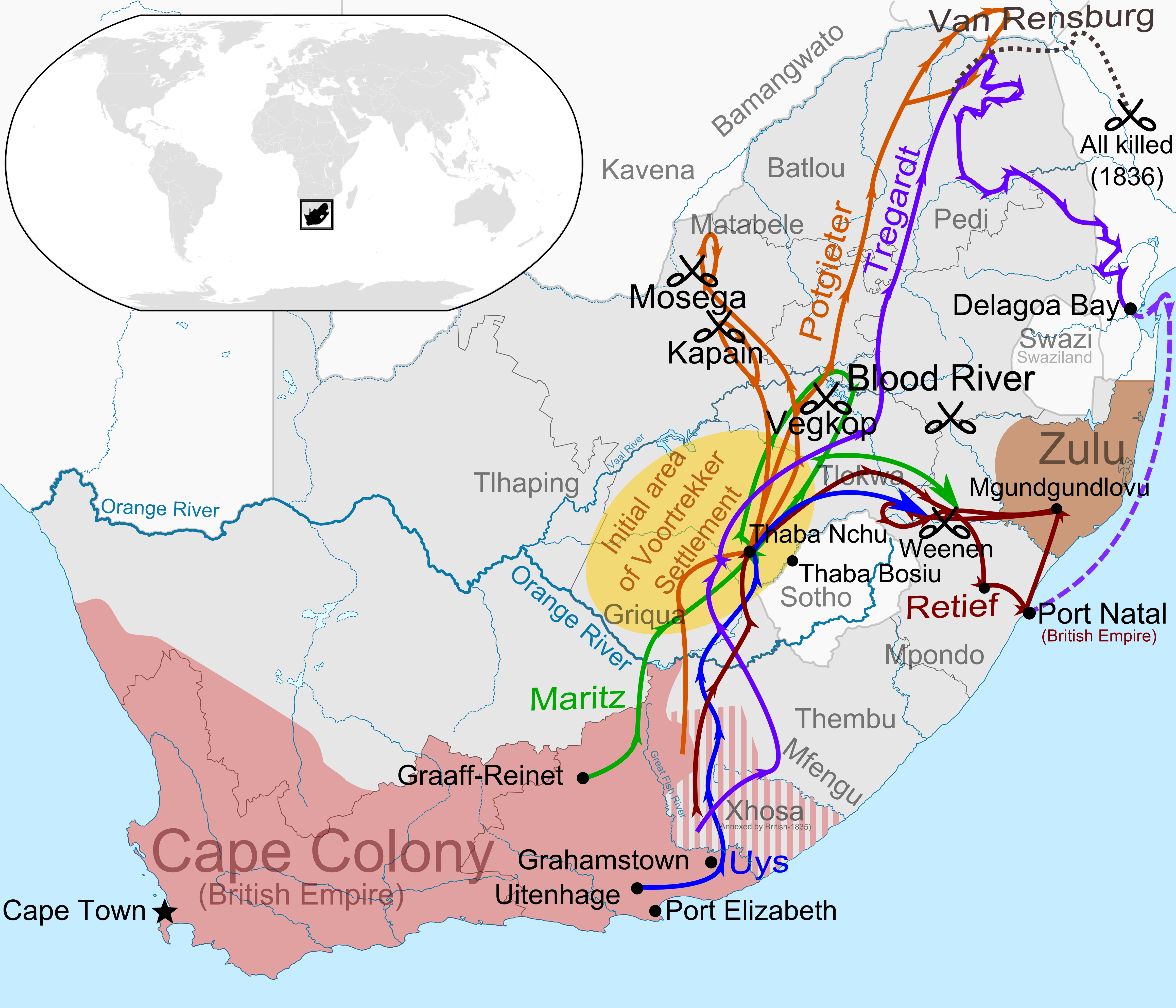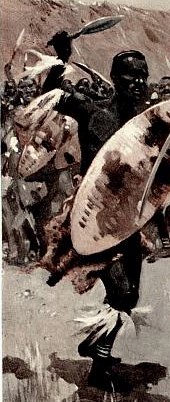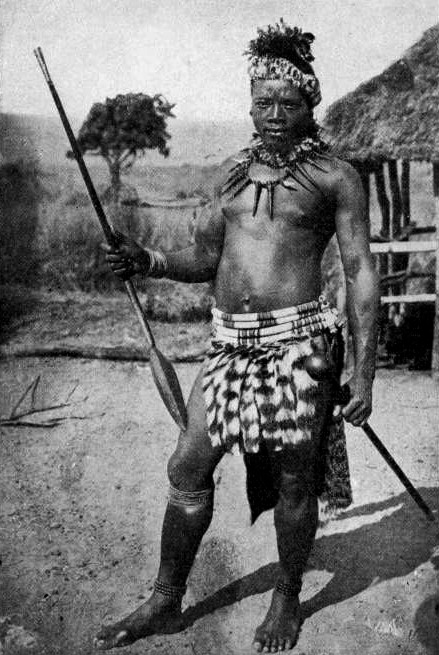|
Johanna Van Der Merwe
Johanna Cornelia van der Merwe (7 March 1825 – 15 January 1888) was a Voortrekker heroine who survived the Weenen massacre, an impi attack on her trekking party on 17 February 1838, despite suffering more than twenty assegai wounds. She later married Hendrik Fredercik Delport with whom she had seven sons (despite being permanently crippled by the attack). She died aged 62 and was buried in Rouxville. An ox-wagon in the historic 1938 Great Trek Centenary commemoration trek as well as a South African Navy submarine A submarine (or sub) is a watercraft capable of independent operation underwater. It differs from a submersible, which has more limited underwater capability. The term is also sometimes used historically or colloquially to refer to remotely op ... were named in her honour. References Afrikaner people South African people of Dutch descent 1825 births 1888 deaths {{SouthAfrica-bio-stub ... [...More Info...] [...Related Items...] OR: [Wikipedia] [Google] [Baidu] |
Moorreesburg
Moorreesburg is a rural town situated about north of Cape Town, in the Western Cape province of South Africa. It was laid out in 1879 on the farm Hooikraal, was administered by a village management board from 1882 and attained municipal status in 1909. Today it falls within the Swartland Local Municipality, which is part of the West Coast District Municipality. The town is the seat of government for the West Coast District Municipality. Moorreesburg lies just off the N7 national road, at a driving distance of from Cape Town. The R311 regional road also passes through the town, as does the West Coast branch line railway. It has two public primary schools, one public high school, a library, a police station, a magistrate's court, and a health clinic. History and economy Moorreesburg was named after J.C. le Febre Moorrees (1807–1885), minister of the Swartland congregation of the Nederduitse Gereformeerde Kerk from 1833 to 1881. In 1889 a village council was established, b ... [...More Info...] [...Related Items...] OR: [Wikipedia] [Google] [Baidu] |
Voortrekker
The Great Trek ( af, Die Groot Trek; nl, De Grote Trek) was a Northward migration of Dutch-speaking settlers who travelled by wagon trains from the Cape Colony into the interior of modern South Africa from 1836 onwards, seeking to live beyond the Cape's British colonial administration. The Great Trek resulted from the culmination of tensions between rural descendants of the Cape's original European settlers, known collectively as ''Boers'', and the British Empire. It was also reflective of an increasingly common trend among individual Boer communities to pursue an isolationist and semi-nomadic lifestyle away from the developing administrative complexities in Cape Town. Boers who took part in the Great Trek identified themselves as ''voortrekkers'', meaning "pioneers", "pathfinders" (literally "fore-trekkers") in Dutch and Afrikaans. The Great Trek led directly to the founding of several autonomous Boer republics, namely the South African Republic (also known simply as the '' ... [...More Info...] [...Related Items...] OR: [Wikipedia] [Google] [Baidu] |
Weenen Massacre
The Weenen massacre ( af, Bloukransmoorde) was the massacre of Khoikhoi, Basuto and Voortrekkers by the Zulu Kingdom on 17 February 1838. The massacres occurred at Doringkop, Bloukrans River, Moordspruit, Rensburgspruit and other sites around the present day town of Weenen in South Africa's KwaZulu-Natal province. Massacre After killing Piet Retief and about 100 people of his delegation, the Zulu King Dingane sent his impis to kill the remaining voortrekkers who were camped at Doringkop, Bloukrans (Blaauwekrans), Moordspruit, Rensburgspruit and other sites along the Bushman River ( zu, Mtshezi), in the present province of KwaZulu-Natal, South Africa, near the town of Weenen. "Not a soul was spared. Old men, women and babies were murdered in the most brutal manner." Death toll Among the Voortrekkers, 41 men, 56 women and 185 children were killed. In addition another 250 or 252 Khoikhoi and Basuto that accompanied the Voortrekkers were killed, bringing the casualties to 5 ... [...More Info...] [...Related Items...] OR: [Wikipedia] [Google] [Baidu] |
Impi
is a Zulu word meaning war or combat and by association any body of men gathered for war, for example is a term denoting an army. were formed from regiments () from (large militarised homesteads). In English is often used to refer to a regiment, which is called an in or the army. Its beginnings lie far back in historic local warfare customs, when groups of armed men called battled. They were systematised radically by the king Shaka, who was then only the exiled illegitimate son of king Senzangakhona kaJama, but already showing much prowess as a general in the army () of Mthethwa king Dingiswayo in the Ndwandwe–Zulu War of 1817–1819. Genesis of the impi The Zulu impi is popularly identified with the ascent of Shaka, ruler of the relatively small Zulu tribe before its explosion across the landscape of southern Africa, but its earliest shape as an instrument of statecraft lies in the innovations of the Mthethwa chieftain Dingiswayo, according to some historians ( ... [...More Info...] [...Related Items...] OR: [Wikipedia] [Google] [Baidu] |
Assegai
An assegai or assagai (Arabic ''az-zaġāyah'', Berber languages, Berber ''zaġāya'' "spear", French language, Old French ''azagaie'', Spanish ''azagaya'', Italian ''zagaglia'', Middle English ''lancegay'') is a pole weapon used for throwing, usually a light spear or javelin made up of a wooden handle and an iron tip. Area of use The use of various types of the assegai was widespread all over Africa and it was the most common weapon used before the introduction of firearms. The Zulu people, Zulu, Xhosa people, Xhosa and other Nguni people, Nguni tribes of South Africa were renowned for their use of the assegai. ''Iklwa'' Shaka of the Zulu people, Zulu invented a shorter stabbing spear with a two-foot (0.61 m) shaft and a larger, broader blade one foot (0.3 m) long. This weapon is otherwise known as the ''iklwa'' or ''ixwa'', after the sound that was heard as it was withdrawn from the victim's wound. The traditional spear was not abandoned, but was used to ranged we ... [...More Info...] [...Related Items...] OR: [Wikipedia] [Google] [Baidu] |
Rouxville
Rouxville is a small wool and cattle farming town in the Free State province of South Africa and is situated on the N6 national route. The town is at the centre of the wool producing area of the Transgariep. Rouxville is situated near a number of interesting locations - Zastron (30 km), Aliwal North (34 km), Smithfield (35 km), Gariep Dam (60 km) and Bethulie. Lady Grey, the Witteberg mountain range (with the 2,769 m Avoca peak) and the Drakensberg mountain range are also easily accessible from Rouxville, while the Lesotho border is ca. 70 km away. History The town started after mail irregularities at Aliwal North led authorities to re-direct mail between the Cape Colony and the Orange Free State to the farm ''Zuurbult'' (founded by Petrus Wepenaar) in 1863. The distance between Smithfield and Aliwal North (70 km) was allegedly too long to be travelled in one day by horse and wagon, and as such Rouxville was created as the halfway stopover. The ... [...More Info...] [...Related Items...] OR: [Wikipedia] [Google] [Baidu] |
Ox-wagon
An ox-wagon or bullock wagon is a four-wheeled vehicle pulled by oxen (draught cattle). It was a traditional form of transport, especially in Southern Africa but also in New Zealand and Australia. Ox-wagons were also used in the United States. The first recorded use of an ox-wagon was around 1670, but they continue to be used in some areas up to modern times. Design Ox-wagons are typically drawn by teams of oxen, harnessed in pairs. This gave them a very wide turning circle, the legacy of which are the broad, pleasant boulevards of cities such as Bulawayo, Zimbabwe, which are wide, and Grahamstown, South Africa, which are "wide enough to turn an ox-wagon". The wagon itself is made of various kinds of wood, with the rims of the wheels being covered with tyres of iron, and since the middle of the 19th century the axles have also been made of iron. The back wheels are usually substantially larger than the front ones and rigidly connected to the tray of the vehicle. The front wheel ... [...More Info...] [...Related Items...] OR: [Wikipedia] [Google] [Baidu] |
Great Trek
The Great Trek ( af, Die Groot Trek; nl, De Grote Trek) was a Northward migration of Dutch-speaking settlers who travelled by wagon trains from the Cape Colony into the interior of modern South Africa from 1836 onwards, seeking to live beyond the Cape's British colonial administration. The Great Trek resulted from the culmination of tensions between rural descendants of the Cape's original European settlers, known collectively as ''Boers'', and the British Empire. It was also reflective of an increasingly common trend among individual Boer communities to pursue an isolationist and semi-nomadic lifestyle away from the developing administrative complexities in Cape Town. Boers who took part in the Great Trek identified themselves as ''voortrekkers'', meaning "pioneers", "pathfinders" (literally "fore-trekkers") in Dutch and Afrikaans. The Great Trek led directly to the founding of several autonomous Boer republics, namely the South African Republic (also known simply as the '' ... [...More Info...] [...Related Items...] OR: [Wikipedia] [Google] [Baidu] |
South African Navy
The South African Navy (SA Navy) is the naval warfare branch of the South African National Defence Force. The Navy is primarily engaged in maintaining a conventional military deterrent, participating in counter-piracy operations, fishery protection, search and rescue, and upholding maritime law enforcement for the benefit of South Africa and its international partners. Today the South African Navy is one of the most capable naval forces in the African region, operating a mixed force of sophisticated warships, submarines, patrol craft, and auxiliary vessels, with over 7,000 personnel; including a marine force. With formerly deep historical and political connections to the United Kingdom, the first emergence of a naval organisation was the creation of the South African Division of the British Royal Naval Volunteer Reserve in 1913, before becoming an nominally independent naval service for the Union of South Africa in 1922. In its history, South African naval vessels and perso ... [...More Info...] [...Related Items...] OR: [Wikipedia] [Google] [Baidu] |
Submarine
A submarine (or sub) is a watercraft capable of independent operation underwater. It differs from a submersible, which has more limited underwater capability. The term is also sometimes used historically or colloquially to refer to remotely operated vehicles and Autonomous underwater vehicle, robots, as well as medium-sized or smaller vessels, such as the midget submarine and the wet sub. Submarines are referred to as ''boats'' rather than ''ships'' irrespective of their size. Although experimental submarines had been built earlier, submarine design took off during the 19th century, and they were adopted by several navies. They were first widely used during World War I (1914–1918), and are now used in many navy, navies, large and small. Military uses include attacking enemy surface ships (merchant and military) or other submarines, and for aircraft carrier protection, Blockade runner, blockade running, Ballistic missile submarine, nuclear deterrence, reconnaissance, conventio ... [...More Info...] [...Related Items...] OR: [Wikipedia] [Google] [Baidu] |
Afrikaner People
Afrikaners () are a South African ethnic group descended from Free Burghers, predominantly Dutch settlers first arriving at the Cape of Good Hope in the 17th and 18th centuries.Entry: Cape Colony. ''Encyclopædia Britannica Volume 4 Part 2: Brain to Casting''. Encyclopædia Britannica, Inc. 1933. James Louis Garvin, editor. They traditionally dominated South Africa's politics and commercial agricultural sector prior to 1994. Afrikaans, South Africa's third most widely spoken home language, evolved as the First language, mother tongue of Afrikaners and most Cape Coloureds. It originated from the Dutch language, Dutch vernacular of South Holland, incorporating words brought from the Dutch East Indies (now Indonesia) and Madagascar by slaves. Afrikaners make up approximately 5.2% of the total South African population, based upon the number of White South Africans who speak Afrikaans as a first language in the South African National Census of 2011. The arrival of Portugal, Portug ... [...More Info...] [...Related Items...] OR: [Wikipedia] [Google] [Baidu] |
South African People Of Dutch Descent
South is one of the cardinal directions or compass points. The direction is the opposite of north and is perpendicular to both east and west. Etymology The word ''south'' comes from Old English ''sūþ'', from earlier Proto-Germanic ''*sunþaz'' ("south"), possibly related to the same Proto-Indo-European root that the word ''sun'' derived from. Some languages describe south in the same way, from the fact that it is the direction of the sun at noon (in the Northern Hemisphere), like Latin meridies 'noon, south' (from medius 'middle' + dies 'day', cf English meridional), while others describe south as the right-hand side of the rising sun, like Biblical Hebrew תֵּימָן teiman 'south' from יָמִין yamin 'right', Aramaic תַּימנַא taymna from יָמִין yamin 'right' and Syriac ܬܰܝܡܢܳܐ taymna from ܝܰܡܝܺܢܳܐ yamina (hence the name of Yemen, the land to the south/right of the Levant). Navigation By convention, the ''bottom or down-facing side'' of a ... [...More Info...] [...Related Items...] OR: [Wikipedia] [Google] [Baidu] |






